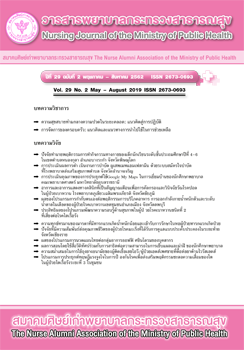ความสม่ำเสมอในการใช้ถุงยางอนามัยของผู้ติดเชื้อเอชไอวี/ ผู้ป่วยเอดส์เพศชายที่ดื้อต่อยาต้านไวรัสเอดส์ ความสม่ำเสมอในการใช้ถุงยางอนามัยของผู้ติดเชื้อเอชไอวี/ ผู้ป่วยเอดส์เพศชายที่ดื้อต่อยาต้านไวรัสเอดส์
Main Article Content
บทคัดย่อ
การวิจัยครั้งนี้ มีวัตถุประสงค์เพื่อศึกษาความสัมพันธ์ระหว่างความสม่ำเสมอในการใช้ถุงยางอนามัยกับปัจจัยที่เกี่ยวข้องโดยใช้กรอบแนวคิดทฤษฎีการวางแผนพฤติกรรม ในผู้ติดเชื้อเอชไอวี/ผู้ป่วยเอดส์ ที่ดื้อต่อยาต้านไวรัสเอดส์ ทั้งชนิดปฐมภูมิและชนิดทุติยภูมิ เพศชาย จำนวน 55 ราย คัดเลือกกลุ่มตัวอย่างแบบเฉพาะเจาะจง เก็บรวบรวมข้อมูลโดยใช้แบบสอบถามข้อมูลส่วนบุคคล การเจ็บป่วยและการรักษา การมีเพศสัมพันธ์ในรอบ 3 เดือนและในอดีต การติดเชื้อเอชไอวีและพฤติกรรมการใช้ถุงยางอนามัย ความสัมพันธ์ระหว่างความสม่ำเสมอในการใช้ถุงยางอนามัยกับปัจจัยปัจจัยที่เกี่ยวข้องตามกรอบแนวคิดทฤษฎีการวางแผนพฤติกรรม ผลการศึกษาพบว่า ผู้ติดเชื้อเอชไอวี/ผู้ป่วยเอดส์ ที่ดื้อต่อยาต้านไวรัสเอดส์ มีอัตราการใช้ถุงยางอนามัยเมื่อมีเพศสัมพันธ์ทุกครั้งร้อยละ 72.7 ความสัมพันธ์ระหว่างความสม่ำเสมอในการใช้ถุงยางอนามัยกับปัจจัยที่เกี่ยวข้องพบว่า ความตั้งใจในการใช้ถุงยางอนามัยมีความสัมพันธ์ต่อความสม่ำเสมอในการใช้ถุงยางอนามัยอย่างมีนัยสำคัญทางสถิติ (r=.534, p<.001) และการรับรู้ความสามารถการควบคุมการใช้ถุงยางอนามัยมีความสัมพันธ์ต่อความสม่ำเสมอในการใช้ถุงยางอนามัยอย่างมีนัยสำคัญทางสถิติ (r=.402, p=.002) ข้อเสนอแนะจากการวิจัย คือ ควรมีการรณรงค์ให้ผู้ติดเชื้อเอชไอวี/ผู้ป่วยเอดส์ที่ดื้อต่อยาต้านไวรัสเอดส์มีความตั้งใจในการใช้ถุงยางอนามัยเมื่อมีเพศสัมพันธ์กับคู่ครอง/คู่นอน สนับสนุนให้ผู้ติดเชื้อเอชไอวี/ผู้ป่วยเอดส์ที่ดื้อต่อยาต้านไวรัสเอดส์มีความสามารถในการควบคุมตนเองเมื่อต้องการใช้ถุงยางอนามัย เพื่อป้องกันการแพร่กระจายเชื้อดื้อยาต้านไวรัสเอดส์สู่คู่ครอง/คู่นอนหรือรับเชื้อเพิ่ม
Article Details
บทความและรายงานวิจัยในวารสารพยาบาลกระทรวงสาธารณสุข เป็นความคิดเห็นของ ผู้เขียน มิใช่ของคณะผู้จัดทำ และมิใช่ความรับผิดชอบของสมาคมศิษย์เก่าพยาบาลกระทรวงสาธารณสุข ซึ่งสามารถนำไปอ้างอิงได้
References
2. Bureau of Aids, TB and STIs. DDC WATCH [internet]. 2014[cited 2015 May]. Available from:file:///C:/Users/Sony/Downloads/DDCWatch-AIDs_1434052790.pdf
3. Sungkanuparph S. HIV drug resistance: pathogenesis of HIV drug resistance. Bangkok: Mohchoaban; 2008. (in Thai)
4. Kiertiburanakul S. HIV drug resistance: primary HIV drug resistance. Bangkok: Mohchoaban; 2008. (in Thai)
5. Joint United Nations Program on HIV/AIDS(UNAIDS) & Word Health Organization (WHO). WHO AIDS statistics- presentation transcript [internet]. 2009[cited 2012 July]. Available from: http://www. slideshare.net/thebrightestman/2009-who-aids-tatistics?src=related_normal&rel=8377394
6. Chantratita W. Maximize the effectiveness of HIV-1 treatment by using molecular techniques, bioinformatics, and pharmacogenomics. Bangkok: Graphichut; 2007. (in Thai)
7. Promsorn C, Termvises P, Ramgomut A, Chumpathat N. The unsafe sexual disease behavior on condom useof the HIV/AIDS patients at the Bamrasnaradura infection institute. International conference AIDS; 2004. abstract no. D12337.
8. Visudtibhan P.J. Predictors of condom use among HIV-infected patients/AIDS with their couples. Ramathibodi Nursing Journal [Internet]. 26 Oct. 2015 [cited 2017 May];21(1):69-1. Available from: https://www.tci-thaijo.org/index.php/RNJ/article/view/23009
9. Rujkorakarn D, Kownaklai J, Khamenkhan K, Meena P, Jandeekrayom S, Piyasuwan S, et al. Overviews on sexual intercourse of HIV infected people taking anti-retroviral drugs: duty or happiness. Journal of Nursing and Health Care.2011; 29(1): 12-21.
10. Rojanawiwat A, Ariyoshi K, Pathipvanich P, Srisawat J, Auwanit W, Sawanpanyalert P. Study of risk factors associated with the HIV-1 transmission among HIV-1 affected couples in Northern Thailand. International conference AIDS;2004. abstract no. WePeA5663.
11. Hayee F, Waeteh S. Health self care for HIV transmission prevention HIV client and AIDS patients in three Southern Border Provinces of Thailand. Princess of Naradhiwas University Journal.2014;6(3):1-12.
12. Ajzen I. The theory of planned behavior. Organizational Behavior and Human Decision Process. 1991;50: 179-211.
13. Albarracin D, Fishbein M, Johnson BT, Muellerleile PA. Theories of reasoned action and planned behaviors as models of condom use: A meta-analysis. Psychological Bulletin. 2001;127:142-161.
14. Prasartwanakit A, Songwathana P, Phetcharat B. Sexual beliefs and patterns among Thai adolescents and youths in educational institutions in Songkhla Province. Songklanagarind Medical Journal.2009;27(5): 369-380.
15. Janepanish P, Dancy BL, Park C. Consistence condom use among Thai young adult males: an application of the theory of planned behavior. Aids Care.2011;23(4): 460-466.
16. Janepanish P, Masuthon S. Predictors of condom use among four groups of young Thai adult males
in Bangkok. Journal of Nursing Science Chulalongkorn University.2014; 26(1): 11-24.
17. Cohen L, Manion, L. Research Methods in Education, 3thed. London: Routledge;1989.
18. Rojpalakorn P, Ruecha Y. Statistics for nursing research and using the SPSS for windows. Bangkok: Mahidol University; 2010. (in Thai)
19. Bureau of Epidemiology Department of Disease Control Ministry of Public Health. AIDS Report[internet].2015[cited 2017 May]. Available from: http://www.boe.moph.go.th/aids/download.php
20. Tangvoraphonkchai K, Sungkanuparph S. The incidence and risk factors of virologic failure in HIV–infected patients receiving the first regimen of antiretroviral therapy. Journal of Infectious Diseases and Antimicrobial Agents.2011; 28(3):161-68.
21. Medhajirapath S. Antiretroviral drug resistance among HIV-l-lnfected patients: A retrospective study. Medical Journal of Srisaket Surin Buriram Hospitals.2012;27(2):191-203.
22. Thai Redcross AIDS Research Center. Articles[internet]. 2012[cited 2012 March]. Available from: http://th.trcarc.org/images/Article2.pdf.
23. Ohata P.J., Avihingsanon A, Ubolyam S, Putcharoen O, Stephen J, Volnysanne A, et al. Updates on HIV treatment and prevention. In The 18th Bangkok International Symposium on HIV Medicine. Asia’s HIV symposium. 2016;249-252.
24. Khaowdang P. factors effect to antiretroviral resistance among peopleliving with hiv/aids at “niranam clinic” phayao hospital phayao province. [thesis]. Phayao: University of Phayao; 2012.
25. Bachanas P, Medley A, Pals S, Kidder D, Antelman G, Benech I, et al. Disclosure, knowledge of partner status, and condom use among HIV-positive patients attending clinical care in Tanzania, Kenya, and Namibia. AIDS Patient Care & STDS. 2013;27(7): 425-435.
